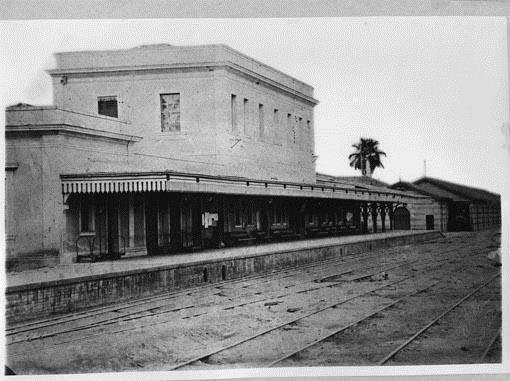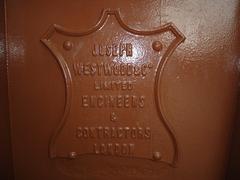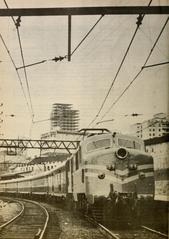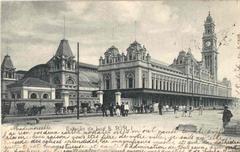
Luz Station São Paulo: Visiting Hours, Tickets, and Historical Site Guide
Date: 14/06/2025
Introduction
Luz Station (Estação da Luz) is one of São Paulo’s most iconic landmarks, reflecting the city’s rich historical, architectural, and cultural legacy. Originally opened in 1867, the station evolved alongside São Paulo’s transformation from a provincial town to Brazil’s economic powerhouse. Its Victorian-inspired design, conceived in Britain and assembled in Brazil, symbolized the city’s global ambitions during the coffee boom era. Today, Luz Station remains a key transport hub and cultural site, home to the acclaimed Museum of the Portuguese Language and surrounded by some of São Paulo’s premier cultural attractions.
This guide provides a detailed overview of Luz Station’s historical significance, practical visiting information—including hours and tickets—and recommendations for exploring the surrounding cultural district. Drawing on authoritative sources like Wikipedia, Google Arts & Culture, and leading travel platforms, this article is your essential resource for planning a visit to one of Brazil’s most treasured landmarks.
Contents
- Historical Overview
- Early Foundations and the Coffee Cycle
- British Influence and Architectural Grandeur
- Luz Station’s Role as São Paulo’s Gateway
- Fires, Reconstruction, and Urban Evolution
- Heritage Protection and Modern Adaptation
- Museum of the Portuguese Language
- Luz Station in the Urban Landscape
- The Touristic Express
- Visitor Information
- Visiting Hours
- Tickets and Entry Fees
- Directions and Accessibility
- Guided Tours and Events
- Photographic Highlights
- Nearby Attractions
- Frequently Asked Questions (FAQ)
- Architectural and Cultural Significance
- Visitor Experience and Travel Tips
- Multimodal Transport and Facilities
- Practical Advice for Tourists
- Summary and Recommendations
- Sources
Historical Overview
Early Foundations and the Coffee Cycle
Luz Station began as a modest terminus in 1867, supporting the São Paulo Railway Company’s crucial link between the port of Santos and the city’s growing interior. As São Paulo’s coffee exports surged, so did the need for expanded infrastructure. The station was rebuilt in 1888 in a neoclassical style, reflecting the city’s rapid development and the growing importance of rail transport to the Brazilian economy (Google Arts & Culture; Wikipedia).
British Influence and Architectural Grandeur
The current Luz Station, completed in 1901, is a remarkable example of British-inspired eclectic architecture. Designed by Charles Henry Driver and fabricated in Glasgow, Scotland, the building’s components were shipped to Brazil for assembly. Its grand clock tower, intricate ironwork, and spacious halls reflected São Paulo’s ambitions as a global city at the turn of the 20th century (Wikipedia; Google Arts & Culture; Reddit).
Luz Station’s Role as São Paulo’s Gateway
Throughout the early 20th century, Luz Station served as the principal entrance to São Paulo, handling both the export of coffee and the arrival of imported goods and immigrants. It became a focal point for urban activity, welcoming dignitaries and integrating the city’s social and economic life (Google Arts & Culture).
Fires, Reconstruction, and Urban Evolution
A devastating fire in 1946 destroyed much of the station’s east wing and clock tower. Reconstruction efforts faithfully restored the original design by 1951. The nationalization of the São Paulo Railway in 1947 and subsequent urban growth transformed Luz Station into a vital component of São Paulo’s expanding metropolitan transit network (Google Arts & Culture).
Heritage Protection and Modern Adaptation
Recognized as a protected heritage site, Luz Station has undergone careful restoration, notably in the early 2000s. It now incorporates the Luz Metro station, connecting multiple metro and commuter rail lines, and continues to serve hundreds of thousands of passengers daily (Wikipedia).
Museum of the Portuguese Language
Since 2006, Luz Station has housed the Museum of the Portuguese Language, an innovative institution celebrating the evolution and diversity of the Portuguese language (Wikipedia; Museum of the Portuguese Language Official Site). The museum’s interactive exhibits and cultural programming further cement Luz Station’s status as a hub of both transport and culture.
Luz Station in the Urban Landscape
Situated on the border of the Bom Retiro and Campos Elíseos districts, Luz Station anchors a vibrant cultural district. The nearby Jardim da Luz park and Pinacoteca do Estado art museum reinforce its role as a focal point in São Paulo’s urban fabric (Wikipedia; GoAskALocal).
The Touristic Express
Since 2009, Luz Station has served as the terminus for the Touristic Express heritage rail line, offering scenic excursions to Paranapiacaba and Jundiaí on vintage trains—a nostalgic journey through São Paulo’s railway history (Wikipedia).
Visitor Information
Visiting Hours
- Luz Station: Open daily from approximately 4:40 AM to midnight.
- Museum of the Portuguese Language: Tuesday to Sunday, 10:00 AM–5:00 PM (last entry at 4:00 PM). Closed on Mondays and select holidays (Museum of the Portuguese Language Official Site).
Tickets and Entry Fees
- Station Access: Free.
- Museum of the Portuguese Language: ~R$20, with discounts for students, seniors, and children.
- Touristic Express: Ticket prices vary; advance booking is advised (Tripomatic).
Directions and Accessibility
Accessible via Metro Line 1-Blue, Line 4-Yellow, and CPTM Lines 7-Ruby, 11-Coral, and 13-Jade (Airport-Express). Bus connections are extensive. The station features elevators, ramps, tactile paving, and bilingual signage (Concrete Jungles Tour).
Guided Tours and Events
Guided tours of the station and museum are available (Portuguese/English). Check official sites for schedules and booking information. The station regularly hosts cultural events and exhibitions (Museum of the Portuguese Language Official Site).
Photographic Highlights
Best photo spots include the clock tower, ironwork façade, and adjacent gardens. Early morning or late afternoon offers optimal natural light.
Nearby Attractions
- Museum of the Portuguese Language (inside Luz Station)
- Pinacoteca do Estado (São Paulo’s oldest art museum)
- Jardim da Luz (historic public park)
- Bom Retiro neighborhood (markets, diverse dining, and shopping)
Frequently Asked Questions (FAQ)
Q: What are Luz Station’s visiting hours?
A: 4:40 AM–midnight daily; museum hours differ.
Q: Is there an entry fee?
A: Station access is free; museum and heritage train require tickets.
Q: How do I buy tickets?
A: Museum tickets online or at the entrance; Touristic Express tickets online or at the station.
Q: Is Luz Station accessible?
A: Yes, with elevators, ramps, and assistance for those with mobility needs.
Q: What is the best way to get there?
A: Metro (Lines 1-Blue or 4-Yellow) or CPTM trains are recommended.
Q: Is it safe to visit?
A: The station and immediate area are generally safe during the day. Use standard urban precautions (Travel Week São Paulo).
Architectural and Cultural Significance
- Design: Victorian-inspired, fabricated in Scotland, assembled in São Paulo (Nannybag Guide).
- Features: Grand clock tower, ornate ironwork, spacious glass-lit halls.
- Preservation: Restored after the 1946 fire and in the early 2000s, maintaining historical integrity.
- Cultural Impact: Arrival point for immigrants, central to São Paulo’s economic and cultural development, and a hub for major cultural institutions (GoAskALocal; Touropia).
Visitor Experience and Travel Tips
- Navigation: Clear bilingual signage and accessible facilities.
- Tickets: Bilhete Único smart card allows seamless transit across metro, trains, and buses (MetroEasy).
- Amenities: Restrooms, cafes, shops, tourist information desks, and security (TravelRight).
- Safety: Remain vigilant against petty crime; avoid isolated areas at night (Travel Week São Paulo).
- Weather: São Paulo’s climate is mild; dress for comfort and bring an umbrella during the rainy season (Tour Travel World).
Multimodal Transport and Facilities
- CPTM Lines: 7-Ruby, 11-Coral, 13-Jade (Airport-Express).
- Metro Lines: 1-Blue (north-south), 4-Yellow (automated, deep-level).
- Bus Connections: Extensive, including BRT (Urban Transport Magazine).
- Airport Access: Direct via Line 13-Jade (Wikipedia).
- Future Developments: Network expansion and modernization are underway (Rail Journal).
Summary and Recommendations
Luz Station is more than a transport gateway—it is a living testament to São Paulo’s historical journey and urban dynamism. With its architectural grandeur, central location, and cultural offerings, the station is a must-visit for travelers and locals alike. For the most current information on visiting hours, tickets, and cultural events, consult official sources and consider downloading the Audiala app for real-time updates and self-guided tours.
Internal Links
External Resources
Visual Suggestions
- Include high-quality images of Luz Station’s façade, clock tower, interior, Museum of the Portuguese Language, and Jardim da Luz.
- Use alt tags such as “Luz Station exterior,” “Luz Station clock tower,” and “Museum of the Portuguese Language interior.”
- Embed interactive maps or virtual tours if available.
Sources
- Wikipedia
- Google Arts & Culture
- Nannybag Guide
- Touropia
- Travel Week São Paulo
- Tour Travel World
- Concrete Jungles Tour
- Tripomatic
- Rail Journal
- Urban Transport Magazine
- Museum of the Portuguese Language Official Site
- GoAskALocal
- Herzog & de Meuron
- TravelRight
- MetroEasy







































































































































































